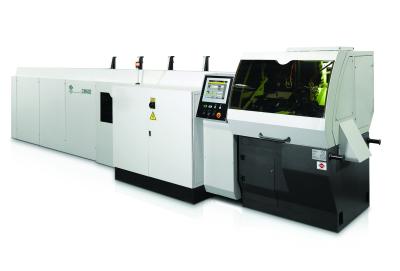
BLM Group USA has announced the introduction of the CM602 automatic CNC sawing machine. The CM602 can handle tube and bar up to 4 in. in diameter, depending on the material, and can achieve blade speeds up to 5,000 rpm. It is ideal for cutting short and medium length steel, copper, brass and aluminum tubes, as well as solid bars and custom profiles. Its compact layout, rugged construction and precise handling of the material during the entire cutting process makes it a good choice for continuous production operations.
The CM602 is an operator-friendly machine. The operator is assisted with detailed step-by-step instructions via icons on a touchscreen panel. By entering the tube shape, material thickness, the cut length and the material type, the machine selects the appropriate blade from its library, calculates the stroke, the cutting head feed rate, the blade speed, and then monitors the chip load to prevent the blade from being overloaded and developing damaging excessive heat.
The material is loaded into the cutting area by a servomotor carriage, providing highly repeatable positioning and accuracy of the cut lengths. At the end of the cut, during the return movement of the head, the bar is retracted to enable its detachment from the blade, which preserves the material’s end finish and increases the saw blade’s lifetime.
The cutting head is positioned at 45° to the tube surface. Its linear movement across the tube provides a uniform load on the blade resulting in reduced noise and less scrap.
Contact Details
Related Glossary Terms
- computer numerical control ( CNC)
computer numerical control ( CNC)
Microprocessor-based controller dedicated to a machine tool that permits the creation or modification of parts. Programmed numerical control activates the machine’s servos and spindle drives and controls the various machining operations. See DNC, direct numerical control; NC, numerical control.
- feed
feed
Rate of change of position of the tool as a whole, relative to the workpiece while cutting.
- sawing
sawing
Machining operation in which a powered machine, usually equipped with a blade having milled or ground teeth, is used to part material (cutoff) or give it a new shape (contour bandsawing, band machining). Four basic types of sawing operations are: hacksawing (power or manual operation in which the blade moves back and forth through the work, cutting on one of the strokes); cold or circular sawing (a rotating, circular, toothed blade parts the material much as a workshop table saw or radial-arm saw cuts wood); bandsawing (a flexible, toothed blade rides on wheels under tension and is guided through the work); and abrasive sawing (abrasive points attached to a fiber or metal backing part stock, could be considered a grinding operation).
- sawing machine ( saw)
sawing machine ( saw)
Machine designed to use a serrated-tooth blade to cut metal or other material. Comes in a wide variety of styles but takes one of four basic forms: hacksaw (a simple, rugged machine that uses a reciprocating motion to part metal or other material); cold or circular saw (powers a circular blade that cuts structural materials); bandsaw (runs an endless band; the two basic types are cutoff and contour band machines, which cut intricate contours and shapes); and abrasive cutoff saw (similar in appearance to the cold saw, but uses an abrasive disc that rotates at high speeds rather than a blade with serrated teeth).
- sawing machine ( saw)2
sawing machine ( saw)
Machine designed to use a serrated-tooth blade to cut metal or other material. Comes in a wide variety of styles but takes one of four basic forms: hacksaw (a simple, rugged machine that uses a reciprocating motion to part metal or other material); cold or circular saw (powers a circular blade that cuts structural materials); bandsaw (runs an endless band; the two basic types are cutoff and contour band machines, which cut intricate contours and shapes); and abrasive cutoff saw (similar in appearance to the cold saw, but uses an abrasive disc that rotates at high speeds rather than a blade with serrated teeth).
